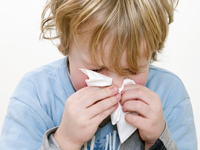More than an attack of the sneezes

 Runny noses, itchy eyes and sneezing are all symptoms that signal the start of a common cold but, for 20 per cent of the population, including many school students, it will be the onset of allergic rhinitis.
Runny noses, itchy eyes and sneezing are all symptoms that signal the start of a common cold but, for 20 per cent of the population, including many school students, it will be the onset of allergic rhinitis.
Allergic rhinitis is an inappropriate immune system response to an allergen – most commonly dust mites, pet dander, pollen and mould. In some sufferers, an allergy to a type of food can also trigger allergic rhinitis.
Sid Nannegari, area sales manager for Neilmed Pharmaceuticals, manufacturer of nasal irrigation systems, says allergic rhinitis is the inflammation of the nasal passages and is a reaction that happens when the immune system overreacts to substances that have been inhaled, such as pollen.
“There are two types of allergic rhinitis – seasonal allergic rhinitis (hay fever) and perennial allergic rhinitis, which occurs year-round. Hay fever is caused by outdoor allergens. Perennial allergic rhinitis is caused by indoor allergens such as dust mites, pet dander, and mould,” he says.
Hay fever is commonly triggered by wind-borne pollen from trees, grass and weeds. Early spring symptoms point to tree pollen, while nasal allergy in late spring and summer indicates that grass and weed pollens are the culprits. And overlapping the grass season is the weed pollen season, which usually starts in late spring and extends through to the end of summer.
In New Zealand the seasons are not very distinct and vary throughout the country because of the different climates. The season starts about one month earlier at the top of the North Island than the bottom of the South Island.
Perennial allergic rhinitis is usually caused by house dust mites, pets, or mould. Sufferers are often allergic to more than one allergen, such as dust mite and pollen, so may suffer from symptoms for months on end or all year round and additional irritants such as strong perfumes and tobacco smoke can aggravate the condition.
As well as sneezing, a runny nose and itchy eyes, symptoms of allergic rhinitis can include a sore throat, dry cough, headaches, fatigue and dark circles under the eyes.
Recent studies have revealed that one in five people are affected by allergic rhinitis, and of that about a third develop problems before the age of 10. Around 50 per cent of sufferers experience symptoms for more than four months of the year and 20 per cent have symptoms for at least nine months of the year.
Because of this, allergic rhinitis can have a huge impact on quality of life. Persistent symptoms can lead to poor quality sleep, which in turn can result in lethargy, poor concentration and behavioural changes. It can also have an impact on learning in young children.
“It can make it difficult for them to concentrate,” says Andrew Bary, pharmacist for online chemist Allergy Pharmacy. “With a systemic allergy they are also going to get tired and run down.”
Students suffering from allergic rhinitis are also more likely to miss days of school. Recent research from the United States suggests almost two million school days are lost every year due to allergic rhinitis.
“Allergic rhinitis results in increased school absenteeism and distraction during class hours,” says Nannegari. “These children are often embarrassed in school and have decreased social interaction which significantly hampers the process of learning and school performance. All these aspects upset the family too,” he says. “To compound the problems, medications have bothersome side effects which cause the children to resist therapy.”
Treatments for allergic rhinitis range from decongestants and nasal sprays to more natural remedies
“Antihistamines are probably the most common approach to treating allergic rhinitis symptoms,” says Bary. “However it is possible to use non-pharmacological treatments if you can pinpoint the specific triggers.”
Nannegari agrees: “Sinus rinsing, for example, is a safe way to remove allergens and pollens, and is quite effective without any side effects.”
Schools can also help students and staff suffering from the symptoms of allergic rhinitis when considering the schools’ overall environment. Reducing humidity in classrooms, for example, can help to reduce the spread of mould which can trigger allergies in some. Removing fixtures that collect dust, like carpet and drapes, can also help, as can having a robust cleaning regime.
Bray recommends that schools look at the plants and grass species within the school grounds to gage which ones could cause allergies. “Silver birch, for example, is a particularly allergenic species,” he says. Privet, wattle, pine and plane trees can also trigger allergies in some sufferers.
“Timing the mowing of grass so that it is outside of school hours can also help,” he says.
Neilmed’s Nannegari also suggests minimising exposure to allergens by avoiding lawn mowing and other activities likely to stir up outdoor moulds and pollens. “Seasonal allergens (such as tree, grass and ragweed pollens) are difficult to avoid outdoors, but can be controlled by closing windows and running air conditioners,” he says.
To find out more about allergic rhinitis and download a free pollen calendar, go to www.allergy.org.nz.
By Rebecca Wood









